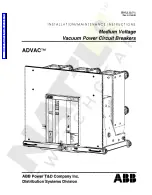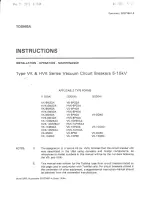
When the main piston approaches the end of its
stroke, the roller on the trip end of the main lever
strikes the sloping face of the latch, forcing it to
rotate counter-clockwise about its fulcrum pin. As
the main lever moves further down toward the
closed position, it forces the pawl lever down thus
freeing the trigger to rotate clockwise about its
fulcrum pin so that as the roller clears the nose of
the latch and the latch snaps into place, the trigger
engages it to prevent the release of the roller and
opening of the breaker.
When the breaker is nearly closed, the "a" con
tact of the auxiliary switch in series with the
"Y"
or cutoff contactor closes. This energizes the
"Y"
contactor operating coil, causing it to simultaneously
open two contacts in series with the
"X"
closing con
tactor and close a contact which seals in around the
auxiliary switch "a" contact. The opening of the
first contact causes the
"X"
coil to be de-energized
and drop out its contacts. When the second contact
is closed, the
"Y"
coil is sealed in and is thus kept
energized even in case a fault trips the breaker out.
Since the breaker cannot close again until the
"Y"
contactor has been de-energized by opening the
control switch, pumping is prevented.
A third contact on the
"Y"
contactor opens the
intake pilot magnet circuit (slightly ahead of
"X"
contactor drop-out), so that the automatic intake
valve piston returns immediately to the top of its
cylinder, thus allowing the intake valve itself to
close under action of the automatic intake valve
spring. At the same time, the automatic intake valve
piston opens some small ports in its cylinder wall
allowing the air in the main cylinder to exhaust to
atmosphere.
Simple Opening.
Starting with the mechanism
in the closed position, when the control switch on
the switchboard is turned to the "trip" position (see
Fig. 3), the trip coil is energized through the two
auxiliary switch "a" contacts. As the trip plunger
snaps upward to strike the trigger, the latter rotates
counter-clockwise about its fulcrum pin to release
the latch, which is forced back by operating lever
under action of the breaker accelerating spring.
As the opening lever moves upward, it releases the
pawl lever spring engaging the trigger, thus keeping
the trigger spring compressed and the trigger in
readiness for another closing operation.
Close-Open Operation- Pneumatic Trip
Free Action.
If, at the time of closure, some con
dition exists which causes the trip circuit to be
energized, the exhaust pilot valve coil will also be
energized, simultaneously opening the exhaust pilot
8
VALVE CLOSED
VALVE OPEN
FIG. 4.
Operation of Exhaust Pilot Valve
valve and permitting high pressure air from mecha
nism cylinder to act on the head of the exhaust
valve piston. The latter is forced open as shown in
Fig. 4, so that the high pressure air in the main
cylinder is quickly exhausted to atmosphere. This
permits the breaker to open quickly without dis
connecting the breaker operating rods from the
mechanism piston and lever. See also schematic
diagram Fig. 5.
This differs from the solenoid mechanism, with
which it is necessary (due to sluggishness imparted
to the mechanism core by the inductive circuit) to
disconnect the breaker pull rod from the solenoid
www
. ElectricalPartManuals
. com






























